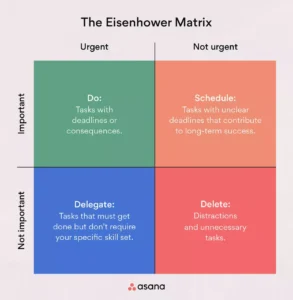

Do you know to know how I use the Eisenhower Decision Matrix to survive in this chaotic and hectic world?
As a small business owner or startup founder, you know that time is your most valuable asset.
You have much to juggle, from sales and marketing to product development and customer service. It’s essential to prioritize effectively to focus on the tasks that will have the most significant impact on your bottom line.
The Eisenhower Decision Matrix is a simple but powerful tool that can help you do just that. It’s a framework for prioritizing tasks based on their importance and urgency.
To use the Eisenhower Decision Matrix, list all your tasks on paper or in a spreadsheet. Then, categorize each task into one of the four quadrants:
Once you’ve categorized your tasks, you can use the following guidelines to prioritize them:
There are many benefits to using the Eisenhower Decision Matrix for SMBs and startups, including:
Here are some specific examples of how you can use the Eisenhower Decision Matrix to prioritize your sales and marketing efforts:
By using the Eisenhower Decision Matrix, you can make sure that you’re working on the most critical sales and marketing tasks that will help you achieve your goals.
Conclusion
The Eisenhower Decision Matrix is a simple but powerful tool that can help SMBs and startups prioritize their tasks and achieve their goals more effectively. Following the tips above, you can use the matrix today to improve your time management and get more done.

Do you know to know how I use the Eisenhower Decision Matrix to survive in this chaotic and hectic world?
As a small business owner or startup founder, you know that time is your most valuable asset.
You have much to juggle, from sales and marketing to product development and customer service. It’s essential to prioritize effectively to focus on the tasks that will have the most significant impact on your bottom line.
The Eisenhower Decision Matrix is a simple but powerful tool that can help you do just that. It’s a framework for prioritizing tasks based on their importance and urgency.
To use the Eisenhower Decision Matrix, list all your tasks on paper or in a spreadsheet. Then, categorize each task into one of the four quadrants:
Once you’ve categorized your tasks, you can use the following guidelines to prioritize them:
There are many benefits to using the Eisenhower Decision Matrix for SMBs and startups, including:
Here are some specific examples of how you can use the Eisenhower Decision Matrix to prioritize your sales and marketing efforts:
By using the Eisenhower Decision Matrix, you can make sure that you’re working on the most critical sales and marketing tasks that will help you achieve your goals.
Conclusion
The Eisenhower Decision Matrix is a simple but powerful tool that can help SMBs and startups prioritize their tasks and achieve their goals more effectively. Following the tips above, you can use the matrix today to improve your time management and get more done.

